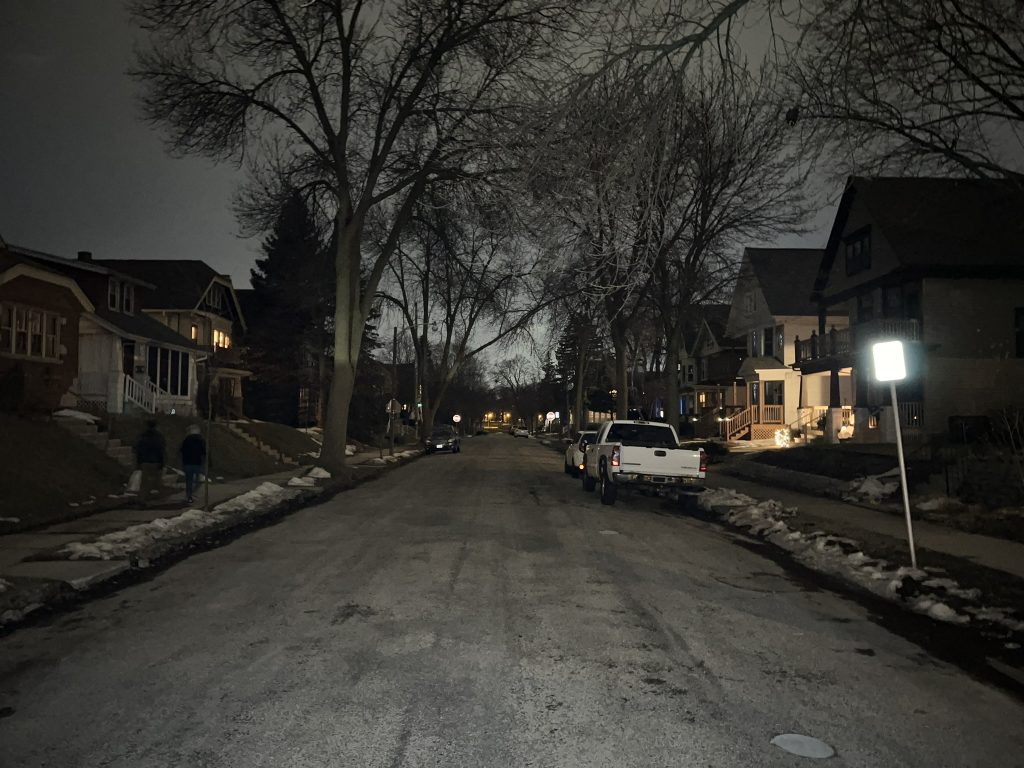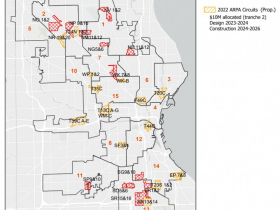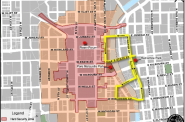Milwaukee Drastically Changing Street Lighting Plan
Switch to LED lights upgrades because contractor shortage leaves city unable to rush to replace failing circuits.
Faced with a contractor shortage and a looming federal grant timeline, the City of Milwaukee is poised to drastically change direction with its attempts to address the failing street lighting system.
The plan will leave the residents who experience the most frequent light outages in the dark longer while a majority of the city will receive visible lighting upgrades.
The Department of Public Works (DPW) intends to switch from an expedited plan to replace the 28 worst-performing light circuits to upgrading to LED lights on newer circuits.
“There have been some challenges,” said City Engineer Kevin Muhs in presenting the proposal to the Public Works Committee Thursday morning. And those challenges are coming as the street lighting fee, instituted in 2021 at approximately $40 per year, was created in part to put the city on a pathway to fixing the issue. “I understand the public’s frustration with the new fee at the same time the system visually failed.”
Things sounded good when they started. The fee was used to raise electrician pay in an attempt to fill vacant positions, part of a strategy to reduce repair times. In fall 2021, the Common Council allocated $10 million from its $394.2 million American Rescue Plan Act grant to replace the 13 worst-performing circuits, strings of nearly century-old wiring that hooks street lights together. In 2022, it added $10 million to replace a second group of 16 circuits. City officials held a press conference to promote the coming improvements, then cut $500,000 in November and one circuit to avoid cuts to other city services.
Approximately 33% of Milwaukee’s street lights are powered by pre-1930s series circuitry (similar to old Christmas tree string lights where a single bad light takes down a whole strand). Much of it lacks any insulation. Water penetrates the system and electricians must rush to triage the issue, knowing that many such problems may come all at once.
The city hired a contractor to design the 28 replacement circuits for $1.2 million, and work is reportedly going as expected. “We are also in the process of purchasing between $7 million to $11 million of supplies,” said Muhs.
But the city can’t find electrical contractors to actually install the new wiring, which imperils the federal funds that need to be spent by 2026. DPW attempted to hire a contractor in June to do the first two circuits. “We got no bids for those two circuits,” said the engineer.
DPW tried again in July and received only a single bid. “It was about two and half times [the cost of] our estimate to do the work,” said Muhs.
The City Engineer attributes the cost increase to a series of issues, starting with the Bipartisan Infrastructure Law. “We didn’t get a 30% bigger contracting industry when the Infrastructure Law passed,” he said. “The contractors basically told us we’re tapped out for the next several years.”
It’s also the first time the city has bid out solely a light circuit replacement project, which would normally be included within a road construction project. Electrical contractors, said Muhs, don’t have the bonding capacity required by city ordinance when working alone. The one July bid the city received had a road builder as a pass-through primary contractor to satisfy the requirement, a structure which Muhs said would increase the cost.
“We tried to explore as much flexibility as we could within the city ordinance and any federal regulations,” said Muhs. “Our primary concern with this is there doesn’t seem to be the capacity period within the electrical contractors to do the work.”
Even if the city decided to pay the increased price to replace the 10 circuits, Muhs, in a memo, doubted contractors could complete the work by the 2026 use-it-or-lose-it federal deadline.
So DPW has a new idea. It will use the approximately $7 million in unspent installation money to replace 25,000 high-pressure sodium street lights with LED lights on the newer multiple circuits, yielding approximately $750,000 in power savings per year. It will then use its in-house electricians to replace the aging series circuits, which can’t support LED lights and more frequently fail, with the equipment it purchases with the federal grant.
“Each circuit is a different size, but we can typically do between two and six circuits per year, we are hoping to accelerate that with this decision though,” said Muhs of the city’s average $2 million capital allocation to street lighting. He said the electrical bill savings would need to be allocated to replacing the circuits.
“That’s an improvement because those LED lights are nice,” said committee chair Alderman Robert Bauman.
DPW thinks it is more likely to expend the funds to complete the already sought LED upgrades because the above-ground work can be performed year-round by contractors and bids have been more reliable. The city has approximately 15,000 LED lights currently and Muhs said funding is in hand to add another 12,000, without the circuitry reallocation. Two-thirds of the city’s circuits currently can support LED lights, which use less energy and are intended to last at least twice as long. By comparison, Muhs said the 28 circuits targeted for replacement represent 3,000 lights.
“There will be obvious improvements in the lighting in every district,” said Muhs, responding to a concern from Alderwoman Milele A. Coggs that the council originally voted for the plan because every district would receive circuitry upgrades.
Muhs said a recent additional raise for electricians is helping build in-house staffing, after the earlier raise failed to attract more applicants. “That being said, there is a nationwide electrician shortage,” he noted.
The committee unanimously endorsed the proposal, but the full council must still endorse the change.
For additional details on the street lighting issue, see our March 2023 coverage.
Damaged Infrastructure and Proposed Replacement Map
Legislation Link - Urban Milwaukee members see direct links to legislation mentioned in this article. Join today
If you think stories like this are important, become a member of Urban Milwaukee and help support real, independent journalism. Plus you get some cool added benefits.
Related Legislation: File 230620




























I hope if they replace the actual streetlights they choose a design that sends the light down instead of into our windows. I’ve seen that used in other cities. The LED lights are very bright and we needed to light our streets, not our yards and houses.